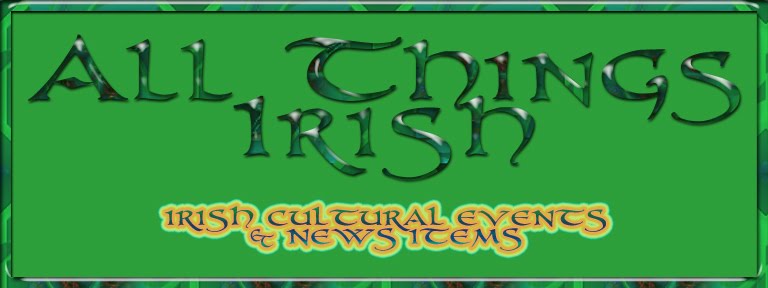Happy Saint Patrick's Day!
A Wee Bit About the
Great Saint Patrick...
Believe it or not; he did NOT invent GREEN BEER!
St Patrick, best known as the Missionary Apostle and patron
Saint of Ireland was born in Roman Britain around 387AD.
Captured as a youth and sold into slavery by Irish pirates;
he turned to his Christian Faith for solace and strength during
his years in captivity. When he finally escaped; he vowed to
return to spread the "GOOD NEWS".
The dates are murky in history but it is believed that he
returned to Ireland as early as 415. We know that he
worked faithfully as a zealous priest and bishop
for the rest of his long life.
(Some sources say that Patrick dies in 493AD;
other sources say 460 or 461. --Ed.)
One thing we know for sure; Patrick was a great man of
strong will and deep faith in the TRIUNE GOD.
Saint Patrick's Breastplate
A prayer and sometime hymn, written and preached by him
has come down to us in several forms;
it was written in Ancient Irish and translated into
Latin during the Middle Ages.
It demonstrates his Faith and Fighting Spirit.
St. Patrick prepared these words before his battles
and debates with the Druids.
He credits these prayers for his victory over Pagans
and his ability to build the Irish Church.
I bind myself today to God's Power to guide me,
God's Might to uphold me.
God's Wisdom to teach me,
God's Eye to watch over me,
God's Ear to hear me,
God's Word to give me speech,
God's Hand to guide me,
God's Way to lie before me,
God's Shield to shelter me...
Christ protect me today;
Against every poison,
Against burning,
Against drowning,
Against death-wounds...
Christ with me,
Christ before me,
Christ behind me,
Christ beneath me,
Christ above me,
Christ at my right,
Christ at my left,
Christ in the fort...
This above excerpt is just a partial English translation;
the entire work can be found online. One source is:
www.newadvent.org/cathen/11554a.htm
Patrick Facts
Here are a few more items of interest about the
Great Saint and his Grand Day!
Did you know that GREEN is associated with the Irish
and Ireland because of the Shamrock and the great green
of the land itself but that Blue was the dominant color
of his vestments.
In Ireland you will often hear the reference
to "St. Patrick Blue"
The Shamrock is also associated with Saint Patrick's Day,
Ireland and the Irish because legend has it
that St. Patrick himself used the little plant, native to Ireland,
to explain how the Trinity or as he called it
THE TRIUNE GOD, could exist as a single entity.
The Irish of the time of Patrick were very tuned into nature
and their surroundings; so it was a perfect metaphor.
Another legend that St. Patrick drove poisonous snakes
out of Ireland; often attributed to him as one of his miracles
is probably not true. Evidence suggests that post-glacial
Ireland never had any snakes in the first place.
EARLY LIFE
We know for sure that St. Patrick was born in Roman Britain
but it is not certain exactly where. Many scholars think
St. Patrick was born in Kilpatrick, near Dumbarton
in Scotland. There is another group that think the great saint
was born in present day Wales.
From his own writings,
we do know that Patrick was born to Christian parents,
that his given name was Maewyn Succat
and that he was kidnapped by Irish pirates at 16
and sold into slavery in Ireland.
At about the age of 20, Saint Patrick escaped
and sailors took him back to Britain.
In a dream he was told to leave Ireland by walking
to the coast and looking for a ship.
Dreams and visions came to him for the rest of his life
and he considered them Divine Intervention.
After studying for the priesthood,
Saint Patrick was ordained
by Saint Germanus, the Bishop of Auxerre around 416.
In 432, Pope Celestine I consecrated him as a bishop.
It is not totally clear if St. Patrick was in
Ireland during all of this period or not.
We do know for sure that Saint Patrick arrived
back to Ireland to spread the
Good News as a
new Bishop. It is written in many ancient texts
that he arrived at Slane on March 25, 433.
Patrick must have spent a lot of his life in good company.
Many of his disciples and converts were
also made saints for their work with him:
Auxilius, Beningnus, Iserninus and Fiacc ,
all were canonized by the early Church.
Most scholars believe that St Patrick died on March 17
in 461AD. It is a national holiday in Ireland
and also on the island of Montserrat in the Caribbean
which was founded by Irish refugees.
It is a bank holiday in Northern Ireland and a provincial holiday
in the Canadian province of Newfoundland.
There have been many failed attempts to make it a
National Holiday in the United States.
Should we be working on making it a legal Holiday?
And finally, here is a great traditional Irish Toast
for St. Patrick's Day;
"May the roof above us never fall in, and
may we friends beneath it never fall out."
Happy Saint Patrick's Day
to You and Yours!
Jim McDonough,
Las Vegas, New Mexico
Here is a link to last week's Irish E-Missive:

